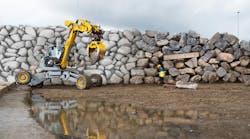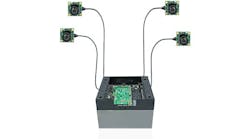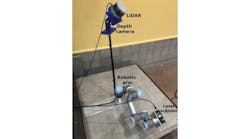SEPTEMBER 14--A new computer program devised by British physicists can quickly spot tiny beetles, rodent droppings, and ergot (a poisonous mold) in grain destined for flour and bread manufacture. Professor Roy Davies and his colleagues in the Machine Vision Research Group at Royal Holloway, University of London, in Egham, Surrey, have found they can run their program on a conventional desktop computer to detect quickly and easily several common contaminants in wheat. The program identifies saw-toothed grain beetles (Oryzaephilus surinamensis), small rodent droppings, and the toxic mold ergot among tens of thousands of grains of wheat.
"The program will help millers, farmers, wholesalers, and other relevant parties to check batches of grain for infestation," says Professor Davies. The program analyzes snapshot images of some 60,000 grains of wheat (about three kg) in just three minutes and identifies insects and certain other nongrain particles using a linear feature detector. At the chosen resolution of the imaging system the adult insects look like short rectangular bars.
The new system overcomes the problem of low contrast between insect and grain and also avoids confusing insects with the dark edges of wheat grains, a cause of false-positive results. "The best results were obtained by integrating two of our previous detectors, thus combining optimum detection sensitivity with fidelity to the original shape," explains Professor Davies. "This ensures accurate recognition."
In recent years, machine vision has been used for many applications such as inspection and surveillance, though several difficulties can arise in taking its use further. One of these is cost; another is the problem of making the necessary computer algorithms (programs) sufficiently effective when dealing with highly variable objects, such as food products and even people going about their daily lives. The present research was funded by the Home-Grown Cereals Authority and carried out in conjunction with Central Science Laboratory, York. It reveals how the system can be used for fast and inexpensive quality control of batches of cereal grain. According to Professor Davies, the basic science involved is highly generic, and the system also might be used in fields as diverse as entomology for tracking insects, transport studies for tracking vehicles and trains on aerial views of the ground, or even in forensics for investigating fingerprints.
The research paper "Combination linear feature detector for effective location of insects in grain images" by Roy Davies, John Chambers, and Chris Ridgway is published in the Institute of Physics journal Measurement Science and Technology 13, 12, (2002) p. 2053.
The Institute of Physics is an international professional body and learned society with more than 37,000 members, which promotes the advancement and dissemination of a knowledge of and education in the science of physics, pure and applied. It has a worldwide membership and is a major international player in scientific publishing and electronic dissemination of physics; setting professional standards for physicists and awarding professional qualifications; and promoting physics through scientific conferences, education and science policy advice.




